Topics 2013
November
30th Anniversary of Sister Port Affiliation between the Fremantle Ports and the Port of Nagoya
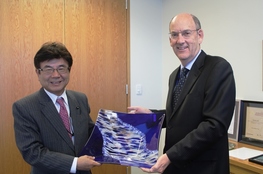
On November 19, the Fremantle Ports and the Nagoya Port Authority celebrated the 30th anniversary of their sister port affiliation at the Port Administration Building in Fremantle.
The 30th anniversary ceremony was held by representatives of Fremantle Ports, including Dr. Jim Limerick, Chairman, Mr. Chris Leatt-Hayter, Chief Executive Officer, Captain Allan Gray, Harbour Master, and Mr. Gino Valent, General Manager Strategy & Planning.
On behalf of the Port of Nagoya, Mr. Setsuo Kurokawa, Vice Chairman of the Nagoya Port Assembly, attended the ceremony and exchanged various information on the latest status at the respective ports with his hosts, strengthening the friendship ties between the two ports.
The sister port affiliation between the Fremantle Ports and the Nagoya Port Authority was signed in 1983. After forming the affiliation, strong and trusting relations have been developed through exchanges of personnel and port-related information and other activities.
August
Ports of Antwerp and Nagoya renew friendship ties
On August 28, the Ports of Antwerp and Nagoya celebrated 25 years of friendship with a ceremony on the construction site for the Deurganckdock lock, to be the world's largest lock when completed in 2016.
The ceremony was attended by Mr. Mitsuo Sakaba, Ambassador of Japan, Mrs. Cathy Berx, Governor of Province of Antwerp, and more than 70 people from public and private entities related to the port business in Antwerp.
The Friendship Port Agreement between the Ports of Antwerp and Nagoya was signed 25 years ago, in 1998. Since that time, this invaluable affiliation has helped to deepen mutual understanding and to develop commercial development between our two regions. The ceremony began with an opening congratulatory address by Governor Berx. Following this, Mr. Marc Van Peel, Chairman of Antwerp Port Authority, Mr. Eddy Bruyninckx, CEO of Antwerp Port Authority, and Mr. Takayuki Kondo, Executive Vice President of Nagoya Port Authority signed the "Sister Port Agreement of the Port of Nagoya and the Port of Antwerp".
This agreement emphasizes cooperation for the betterment of the ties between our two ports, the sharing of best practices in port management, and the increasing of business opportunities for greater cargo flows between the two ports. It was made to further strengthen and renew existing friendship ties on the auspicious occasion of this 25th anniversary year. After the signing ceremony, the signatories and guests viewed the construction works for the Deurganckdock lock and had lively exchanges of views regarding their respective businesses.
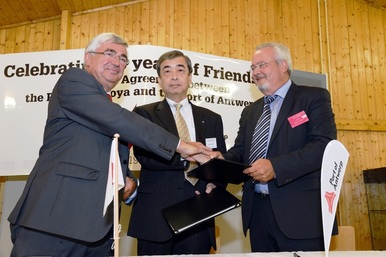
July
Partnership Agreement concluded with Port Authority Zeebrugge
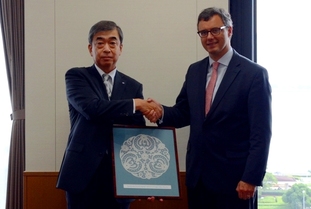
On July 17, Nagoya Port Authority concluded a Partnership Agreement with Port Authority Zeebrugge.
Port Authority Zeebrugge, an autonomous company whose main shareholder is the city of Bruges, manages the Port of Zeebrugge, a major coastal port on the Belgian North Sea Coast.
The Port handled approx. 1.75 million units of completed automobiles and 1.95 million container TEUs last year.
Mr. Joachim Coens, President Managing Director of Port Authority Zeebrugge, and Mr. Takayuki Kondo, Executive Vice President of Nagoya Port Authority, signed the Partnership Agreement to promote trade not only between the two ports but also between Flanders and the Chubu Region. This is the third such agreement signed by the Port of Nagoya, after similar agreements with Shanghai International Port (Group) Co., Ltd. (SIPG) in November 2011 and the Port Authority of Thailand in October 2012.
June
New Executive Vice President of Nagoya Port Authority
Following the retirement of Mr. Takashi Yamada, who worked vigorously to promote and develop the Port of Nagoya, Mr. Takayuki Kondo recently took office as the Executive Vice President of the Nagoya Port Authority. At a press conference, when asked about being the first ever Executive Vice President from the local community, Mr. Kondo said, "For the further development of the Port of Nagoya, which has world-leading manufacturing industries in its hinterland, working together with surrounding cities and neighboring prefectures will become more and more important." In response to a question about the Port's failure to be selected as an international strategic container port by the national government in 2012, Mr. Kondo said, "The Port of Nagoya has high potential and is comparable to the Keihin and Hanshin ports. We will keep working with the national government to receive equal institutional treatment with those ports."
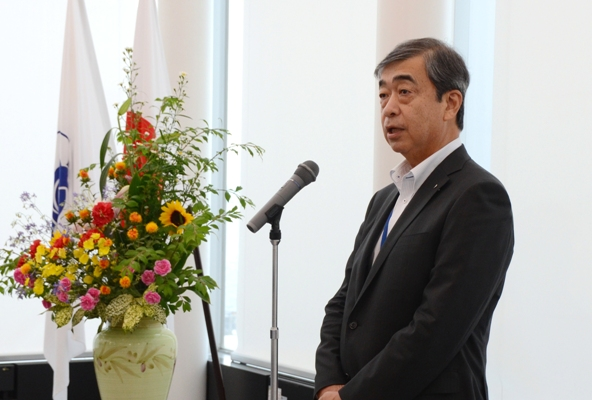
May
First call of passenger cruise ship the Sun Princess at the Port of Nagoya
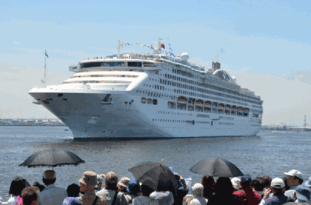
On May 17th, American cruise ship the Sun Princess called at the Port of Nagoya. The Sun Princess is the largest cruise ship in gross tonnage ever to have called at the Port of Nagoya, and was welcomed at the pier with many performances and a large crowd. During the stop at Nagoya, passengers enjoyed optional tours including visits to a Toyota Motor Corporation assembly plant and traditional places like Nagoya Castle. In the evening, a farewell performance was held and the Sun Princess embarked for its next port of call, Yokohama (Japan).
Outline of the Sun Princess
- Gross Tonnage
- 77,000 tons
- Length
- 261.3 m
- Beam
- 32 m
- Draft
- 8.1 m
- Passenger Capacity
- 2,022 persons
- Built Year
- 1995
- Ship Owner
-
PRINCESS CRUISES (USA)
- Flag
- Bermuda
February
Wide area emergency drills conducted at the Port of Nagoya
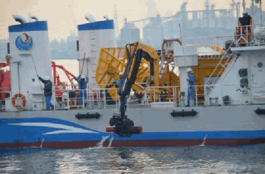
On February 7th, emergency drills were conducted in preparation for the large-scale disaster envisioned from the Nankai Trough earthquake.
These emergency drills were the first comprehensive training exercises jointly carried out by the Cabinet Office of the Government of Japan, local governments from the 4 prefectures of Tokai, 3 cities and other major organizations with a strong association.
At the Port of Nagoya, 20 organizations including the Nagoya Port Authority joined in the drills at the Garden Pier.
Activities conducted on the sea were a search people adrift at sea, a rescue activity, transfer practice, damage status intestigation and various other water way recovery drills. In joint programs on sea and land, the Japan Ground Self-Defense Force () held a critical material handling drill including berthing, discharging and using a dedicated truck to transport material to accumulation bases.
January
First time ever: the Port of Nagoya reaches No. 1 in Japan for export value, outranking Narita International Airport
On January 25th, Nagoya Customs announced provisional figures for 2012 and reported that the Port of Nagoya ranked No. 1 in export value for the first time as far back as they can search the data, to 1979.
The value was 9.7 trillion yen (an increase of 6.7% over the previous year) and this is the first time the Port of Nagoya has ranked No. 1 among all air and sea ports in Japan.
(2nd: Narita International Airport, 3rd: Port of Yokohama)
By major item, the export value for complete automobiles was 2.7 trillion yen (an increase of 18.2% over the previous year) and that for automobile parts was 1.4 trillion yen (an increase of 9.1% over the previous year).
Among trading partners, exports to Thailand increased 29.9% over the previous year. The number of completed automobiles exported was approximately 1.5 million vehicles, also No. 1 in Japan.
On the other hand, import value was 4.6 trillion yen (an increase of 5.8% over the previous year), from an increase in LNG imports of 33.7% over the previous year. Despite the record trade deficit (6.9 trillion yen) in Japan, the Port of Nagoya generated a trade surplus of 5.3 trillion yen (an increase of 7.6%, the first time in two years).
|
Export Value |
Import Value |
Foreign Trade Values |
Deduction | |
|---|---|---|---|---|
|
Value |
9,673,107 |
4,640,778 |
14,313,894 |
5,032,319 |
|
Growth rate |
+6.7% |
+5.8% |
+6.4% |
+7.6 |
|
Export Value(Amount) |
Export Value(Rate) |
Import Value(Amount) |
Import Value(Rate) |
Foreign Trade Values(Amount) |
Foreign Trade Values(Rate) |
Deduction(Amount) |
|
|---|---|---|---|---|---|---|---|
| Nagoya |
9,673,107 |
15.2% |
4,640,788 |
6.6% |
14,313,894 |
10.6% |
5,032,319 |
| Tokyo |
4,687,910 |
7.4% |
8,455,700 |
12.0% |
13,143,610 |
9.8% |
-3,767,790 |
| Yokohama |
6,771,777 |
10.6% |
3,664,496 |
5.2% |
10,436,274 |
7.8% |
3,107,281 |
| kobe |
5,010,177 |
7.9% |
2,619,326 |
3.7% |
7,629,504 |
5.7% |
2,390,851 |
| Osaka |
2,746,955 |
4.3% |
4,171,463 |
5.9% |
6,918,419 |
5.1% |
-1,424,508 |
| 5 Major Ports |
28,889,926 |
45.3% |
23,551,774 |
33.3% |
52,441,700 |
39.0% |
5,338,153 |
| Japan All |
63,744,641 |
100% |
70,671,960 |
100% |
134,416,601 |
100% |
-6,927,319 |
